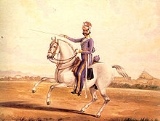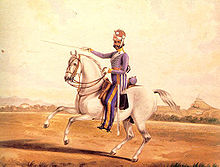
8th King George's Own Light Cavalry
Encyclopedia
The 8th King George's Own Light Cavalry was formed in 1922 by the amalgamation of the 26th King George's Own Light Cavalry and the 30th Lancers following a re-organisation of the Indian Cavalry Corps
. Both regiments were regular cavalry units that had had long and distinguished records in the British Indian Army
prior to their amalgamation. During World War II
the regiment was converted into an armoured car unit and served during the Burma campaign.
Army. In 1788, it was re-designated as the 1st Madras Native Cavalry and in 1816 its name was changed to 1 Madras Light Cavalry. The Regiment was yet again re-named as the 1st Regiment of Madras Lancers in 1886, and was known by that title till the turn of the century, when it was changed to 1st Madras Lancers.
In 1903 it was re-named as the 26th Light Cavalry and three years later it became the Prince of Wales Own Light Cavalry and then in 1910, it became the 26th King George’s Own Light Cavalry. During this time it participated in the Third Mysore War, 1789-1792 , the Fourth Mysore War, 1793-1798. Campaigns against Dhoondia Wagh and the Polygars, 1799-1830. Campaigns in Afghanistan and Burma, between, 1880-1914.

they were brigaded with the 8th (King's Royal Irish) Hussars and the 9th Hodson's Horse They were sent to France
for service on the Western Front
where they at times would serve in the trenches as infantry due to the difference on troop levels each Cavalry Brigade once dismounted formed a dismounted regiment.
The high number of officer casualties suffered early on had an effect on its later performance. British officers that understood the language, customs, and psychology of their men could not be quickly replaced, and the alien environment of the Western Front had some effect on the soldiers.
The Regiment stayed in France as part of the 1st Indian Cavalry Division until March 1918 when the division was broken up and reformed in Egypt.
In 1940, the Regiment started to become mechanised and convert to an Armoured Car Regiment which was not completed until 1943. It went onto serve in Burma with the 19th Indian Division.
In April 1941 the Jat squadron was detached from the Regiment. Renamed as the 100th Light Tank Squadron, it was assigned to the new 44th Cavalry Regiment being formed at Risalpur
. The squadron was sent to Malaya
early in 1942. On January 29, 1942, they arrived in Singapore
with 16 tanks and were attached to the British 18th Infantry Division. The entire squadron was lost when the British forces surrendered on February 15, 1942. Brigadier Avininder Singh Bedi (Bong Bedi) took over Command from the British of the 8th Cavalry Regiment after Independence and was its first Indian commanding officer. Before Independence Brig. AS Bedi was a commanding officer of 3rd cavalry in the British Army
Indian Cavalry Corps
The Indian Cavalry Corps was a formation of the British Indian Army in World War I. It was formed in France in December 1914. It remained in France until March 1916, when it was broken up....
. Both regiments were regular cavalry units that had had long and distinguished records in the British Indian Army
British Indian Army
The British Indian Army, officially simply the Indian Army, was the principal army of the British Raj in India before the partition of India in 1947...
prior to their amalgamation. During World War II
World War II
World War II, or the Second World War , was a global conflict lasting from 1939 to 1945, involving most of the world's nations—including all of the great powers—eventually forming two opposing military alliances: the Allies and the Axis...
the regiment was converted into an armoured car unit and served during the Burma campaign.
26th King George’s Own Light Cavalry
The 26th King George's Own Light Cavalry was originally raised as the 5th Regiment Madras Native Cavalry on 23 October 1787 as part of the Madras PresidencyMadras Presidency
The Madras Presidency , officially the Presidency of Fort St. George and also known as Madras Province, was an administrative subdivision of British India...
Army. In 1788, it was re-designated as the 1st Madras Native Cavalry and in 1816 its name was changed to 1 Madras Light Cavalry. The Regiment was yet again re-named as the 1st Regiment of Madras Lancers in 1886, and was known by that title till the turn of the century, when it was changed to 1st Madras Lancers.
In 1903 it was re-named as the 26th Light Cavalry and three years later it became the Prince of Wales Own Light Cavalry and then in 1910, it became the 26th King George’s Own Light Cavalry. During this time it participated in the Third Mysore War, 1789-1792 , the Fourth Mysore War, 1793-1798. Campaigns against Dhoondia Wagh and the Polygars, 1799-1830. Campaigns in Afghanistan and Burma, between, 1880-1914.

World War I
The 26th King George’s Own Light Cavalry served in the South Yemen during World War I as part of the Aden Field Force, I:30th Lancers (Gordon's Horse)
The 30th Lancers (Gordon's Horse) was formed in 1826 and participated in the Indian Mutiny, 1857-1859 and the Second Burmese War, 1860-1889. From the Second Burmese War to World War I, 1889-1914. Chap V - World War I to the Amalgamation, 1914-1922. Givenchy 1914; France and Flanders 1914-1916; Afghanistan 1919; Iraq 1920.World War I
During the first world war the Regiment was part of the Ambala Cavalry Brigade , 1st Indian Cavalry Division1st Indian Cavalry Division
The 1st Indian Cavalry Division was a regular division of the British Indian Army. The division sailed for France from Bombay on October 16, 1914 , under the command of Major General H D Fanshawe. The division was re designated the 4th Cavalry Division in November 1916. During the war the Division...
they were brigaded with the 8th (King's Royal Irish) Hussars and the 9th Hodson's Horse They were sent to France
France
The French Republic , The French Republic , The French Republic , (commonly known as France , is a unitary semi-presidential republic in Western Europe with several overseas territories and islands located on other continents and in the Indian, Pacific, and Atlantic oceans. Metropolitan France...
for service on the Western Front
Western Front (World War I)
Following the outbreak of World War I in 1914, the German Army opened the Western Front by first invading Luxembourg and Belgium, then gaining military control of important industrial regions in France. The tide of the advance was dramatically turned with the Battle of the Marne...
where they at times would serve in the trenches as infantry due to the difference on troop levels each Cavalry Brigade once dismounted formed a dismounted regiment.
The high number of officer casualties suffered early on had an effect on its later performance. British officers that understood the language, customs, and psychology of their men could not be quickly replaced, and the alien environment of the Western Front had some effect on the soldiers.
The Regiment stayed in France as part of the 1st Indian Cavalry Division until March 1918 when the division was broken up and reformed in Egypt.
Amalgamation
In 1922, the two regiments were amalgamated to form the 8th King George’s Own Light Cavalry, inheriting in the process, the traditions of both Regiments.World War II
World War II 1939-1945; Waziristan 1939-1943; Vizagapatam 1944; Burma 1945, 19th Indian Division, 1946.In 1940, the Regiment started to become mechanised and convert to an Armoured Car Regiment which was not completed until 1943. It went onto serve in Burma with the 19th Indian Division.
In April 1941 the Jat squadron was detached from the Regiment. Renamed as the 100th Light Tank Squadron, it was assigned to the new 44th Cavalry Regiment being formed at Risalpur
Risalpur
Risalpur is a city in Nowshera District, Khyber-Pakhtunkhwa, Pakistan, on the Nowshera-Mardan Road. It is nearly 45 km from Peshawar and 15 km from Mardan and is located at 34°4'52N 71°58'21E. In a basin some 1014 feet above sea level, it is bounded on the south and west by the Kabul and...
. The squadron was sent to Malaya
British Malaya
British Malaya loosely described a set of states on the Malay Peninsula and the Island of Singapore that were brought under British control between the 18th and the 20th centuries...
early in 1942. On January 29, 1942, they arrived in Singapore
Singapore
Singapore , officially the Republic of Singapore, is a Southeast Asian city-state off the southern tip of the Malay Peninsula, north of the equator. An island country made up of 63 islands, it is separated from Malaysia by the Straits of Johor to its north and from Indonesia's Riau Islands by the...
with 16 tanks and were attached to the British 18th Infantry Division. The entire squadron was lost when the British forces surrendered on February 15, 1942. Brigadier Avininder Singh Bedi (Bong Bedi) took over Command from the British of the 8th Cavalry Regiment after Independence and was its first Indian commanding officer. Before Independence Brig. AS Bedi was a commanding officer of 3rd cavalry in the British Army
External links
Follow this link to view the uniforms of the late 19th Century- http://www.members.tripod.com/~Glosters/IAcavalry1.htm

